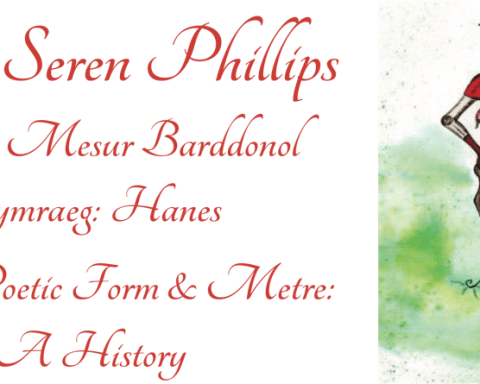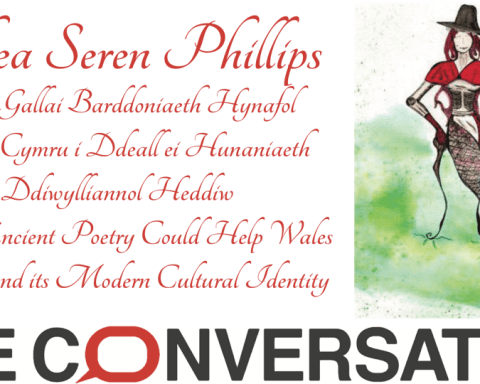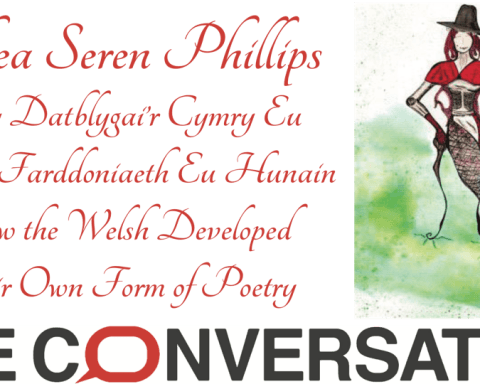Mae Rhea Seren Phillips yn fyfyriwr PhD ym Mhrifysgol Abertawe sy’n ymchwilio i sut y gellir defnyddio ffurfiau a mesurydd barddonol Cymraeg i ailystyried hunaniaeth ddiwylliannol Gymreig gyfoes ac i ennyn diddordeb yn hon. Yma, mae hi’n turio’n ddyfnach i hanes Tywysoges Cymru Gymreig olaf…
Rhea Seren Phillips is a PhD student at Swansea University, who is investigating how the Welsh poetic forms and meter can be used to reconsider and engage with contemporary Welsh cultural identity. Here, she delves deeper into the story of the last Welsh Princess of Wales…
Ymddangosodd y fersiwn Saesneg o’r erthygl hon yn wreiddiol yn The Conversation, gyda chyfres o erthyglau sydd yn cynnwys Cymru yma.
The English version of this article originally appeared in The Conversation, with a series of articles that feature Wales here.
| Wedi rhoddi i lawr y teitl ‘Tywysog Cymru’ y mae cenhedloedd o deulu brenhinol Lloegr – ac yn ddiweddarach, rheolwyr y Deyrnas Unedig – er y 13eg ganrif. Maen nhw’n anrhegu’r aer aparawnt â fe, er nad oes raid i’r aer ei ddal. | The title “Prince of Wales” has been passed down through generations of England’s – and later the United Kingdom’s – royals since the 13th century. It is granted to the heir apparent, though it is not a requirement that the next in line to the throne holds it. |
| Ond nid breninoldeb ‘gwir’ Cymru mo’r tywysogion hyn. Cafodd y teitl ei ddwyn ym 1301 oddi wrth frenhinoedd olaf Cymru, ar ôl y frwydr dros annibyniaeth Gymreig. Ail-grëwyd e ar gyfer Edward o Gaernarfon, oedd i fod yn Edward yr 2ail yn nes ymlaen. Dyma oedd y tro cyntaf yr arwisgen nhw fab hynaf Brenin Lloegr fel ‘Tywysog Cymru’. | But these princes are not the “true” royals of Wales. The title was taken in 1301 from the last monarchs of Wales following the battle for Welsh independence, and recreated for Edward of Caernarfon, the future Edward II. This was the first time that the eldest son of the King of England was invested as “Prince of Wales”. |
| Ers hynny, mae ‘Tywysoges Cymru’ wedi bod y teitl ar wragedd tywysogion Cymru. Yr un gyntaf oedd Joan o Gaint. Derbyniodd hi’r teitl pan briododd Edward o Woodstock, y Tywysog Du – yr ail yn y llinell o dywysogion Cymru a ddeuai o Loegr – ar y 10fed o Hydref 1361. Efallai mai Diana, Tywysoges Cymru, yw’r person mwyaf adnabyddus o bawb sy wedi dal y teitl brenhinol bellach. Wedi dweud hynny, er mwyn cael hyd i wir dywysoges Cymru olaf, hynny yw, y person a anwyd gynt gan frenhinoedd Cymru oedd mewn grym ar y pryd, mae rhaid inni fynd yn ôl i’r 13eg ganrif i ddatguddio hanes Gwenllian. | The wives of the princes of Wales have since been known as “Princess of Wales”. The first was Joan of Kent, who took the title upon her marriage to Edward of Woodstock, the Black Prince – second in the English line of princes of Wales – on October 10 1361. Though Diana, Princess of Wales is now perhaps the most well known of all those to have held the royal title, to find the last true princess of Wales, that is, the last person to be born to the reigning monarchs of Wales, one needs to go back to the 13th Century, and uncover the story of Gwenllian. |
| Tywysoges Cymru Nid tywysoges nodweddiadol mo Gwenllian – ni thriniwyd hi fel un ‘chwaith. Cafodd hi ei geni ym 1282, yn unig blentyn i Llywelyn ap Gruffudd ac Eleanor de Montfort, y llywiau olaf i deyrnasu yng Nghymru. Bu farw mam Gwenllian yn fuan ar ôl genedigaeth y ferch, tra berwai’r brwydro dros annibyniaeth Gymreig a ddygai fywyd ei thad yn yr un flwyddyn hefyd. | Princess of Wales Gwenllian was not a typical princess – nor was she treated like one. Born in 1282, she was the only child of Llywelyn ap Gruffudd and Eleanor de Montfort, the last sovereign royals of Wales. Gwenllian’s mother died shortly after childbirth, amid the fight for Welsh independence which also took the life of her father the same year. |
| Yn blentyn, cafodd Gwenllian ei rhoi o dan ofal ei hewythr, Dafydd ap Gruffudd, ond cafodd e’i ddal ac yn hytrach ei ddienyddio, a hithau’n ddim ond un oed. Wedyn, rhoddwyd y dywysoges ifanc o dan nawdd coron Lloegr. Dim ond yn ystod misoedd cyntaf ei bywyd y byddai Gwenllian yn byw yng ngwlad ei genedigaeth. | Baby Gwenllian was put under the protection of her uncle, Dafydd ap Gruffudd, but he was captured and later executed when she was just one year old. The young princess was then passed into the guardianship of the English crown. The first months of Gwenllian’s life were to be her only time residing in the country of her birth. |
| Pan oedd hi’n groten, fe dalodd y Brenin Edward y 1af y cyfanswm o £20 y flwyddyn i Sempringham, lleiandy yn Swydd Lincoln, i guddio Gwenllian rhag golwg, ac, yn fwyaf pwysig, i’w chadw hi’n ddietifedd. Deallodd y brenin pe bai hi’n esgor ar etifedd, byddai teitl Tywysog Cymru mewn dadl. | When she was a toddler, King Edward I paid Sempringham, a convent in Lincolnshire, the grand sum of £20 a year to keep Gwenllian hidden from view and, most importantly, childless. The king understood that if she produced an heir, then the title of the Prince of Wales would be in dispute. |
| Yn ofalus y dewisodd Edward Sempringham. Nid dim ond lleiandy oedd e, ond ar ben hynny, un a berthynai i Urdd Gilbert, sect seciwlar a gadwai ei hun ar wahân i’r byd. | Edward’s choice of Sempringham was a careful one: it was not just a convent, it was of the Gilbertine Order, a secular sect that kept itself isolated from the world. |
| Daeth Gwenllian yn gysgod a dim ond pan fyddai reidrwydd y câi hi ei hatgyfodi -- pryd bynnag yr oedd angen arian ar y lleiandy, er enghraifft. Fe fyddai’r Brenin Edward y 1af yn atgoffa’r Pab am y fenyw roedd Sempringham yn ei gwarchod – er y byddai’n fwy priodol dweud ei bod yn garcharor. | Gwenllian became a shadow only to be resurrected during great need – when the convent needed money, for example. King Edward I would remind the Pope who Sempringham was a guardian of – although the more appropriate word would have been prisoner. |
| Bu Gwenllian fyw nes iddi gyrraedd ei 54 oed. Dim ond ychydig rydym ni’n ei wybod am ei phersonoliaeth, neu hyd yn oed am ei gwedd hi. Doedd hi ddim yn gwybod ei henw cywir ei hun hyd yn oed: mae cofnodion y priordy’n ei rhestru hi fel ‘Wencilian’ tra oedd hi’n defnyddio’r llofnod ‘Wentliane’ – a llygredigaethau Saesneg yr ynganiad cywir ydyn nhw ill dau. Un o golledigion Cymru ydy hi, wedi’i chladdu yn anialdir Lloegr, bell oddi cartref. | Gwenllian lived until the age of 54. Little is known of her personality and even her appearance. She didn’t even know her true name: priory records have her listed as “Wencilian” while she used the signature “Wentliane” – both English corruptions of the correct pronunciation. She is a lost figure of Wales, buried in the wilderness of England, far from home. |
| Hanes wedi’i golli Ni lwyddodd cynllun Edward y 1af o ran Gwenllian yn llwyr, fodd bynnag. Er nad hanes Chymru na Lloegr sy’n ei chrybwyll hi lawer erbyn hyn, mae atgof y dywysoges golledig o Gymru wedi llwyddo i oroesi, yn rhannol o ganlyniad i grŵp anarferol o gynghreiriaid, sef, beirdd. | Lost history Edward I’s plans for Gwenllian did not succeed entirely, however. Though little mention is to be found now in the history of either Wales or Britain, the memory of the lost Welsh princess has managed to survive, partly thanks to an unusual group of allies: poets. |
| Ychydig bach a ysgrifennwyd am Gwenllian tra oedd hi’n cael ei chuddio. Wedi’r cwbl, gan mwyaf roedd beirdd Cymru yn y Canol Oesoedd yn gwneud â chadw atgof y brenin yn fyw, nid atgof gwraig ddibwys. Ond, fe oroesai eiliwiau ei hanes, diolch i glerddynion. | Very little was written about Gwenllian during her imprisonment, after all the poets of medieval Wales were mostly concerned with preserving the memory of the king, and not that of a mere woman. But glimmers of her story lived on thanks to wandering bards. |
| Mae beirdd Cymraeg wedi dal i gadw ei chof hi’n fyw yn yr oes fodern. Ym 1997 yr adfywiwyd hanes Gwenllian pan ddewisodd y Brifwyl hi fel ei thema y flwyddyn honno – ac wrth gwrs, yr ŵyl fwyaf o ran cerddoriaeth a barddoniaeth yn Ewrop yw’r Eisteddfod Genedlaethol. Ers hynny dim ond wedi blodeuo mae ei dylanwad, gan ddadebru dychymig Cymru – ac o ganlyniad, mae’n sicr y bydd gwir dywysoges Cymru olaf yn dal i fyw o hyd. | Welsh poets have continued to preserve her memory into the modern age. In 1997, Gwenllian’s story was revived when the princess was chosen as the theme for that year’s National Eisteddfod – the largest music and poetry festival in Europe. Her influence has only blossomed since, reinvigorating Wales’s imagination – and so ensuring that the last true princess of Wales lives on. |
Ynom ni mae Gwenllïan, | Within us is Gwenllian, |
O Yn Sempringham gan Mererid Hopwood. |
|
Mwy am Princess Gwenllian |  |
Mae Patrick Jemmer wedi creu’r fersiwn Cymraeg i parallel.cymru / Patrick Jemmer has created the Welsh version for parallel.cymru
![]()





